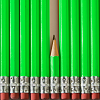There are 24 NRICH Mathematical resources connected to Nets, you may find related items under 3D geometry, shape and space.
Broad Topics > 3D geometry, shape and space > NetsA spider is sitting in the middle of one of the smallest walls in a room and a fly is resting beside the window. What is the shortest distance the spider would have to crawl to catch the fly?



Each of the nets of nine solid shapes has been cut into two pieces. Can you see which pieces go together?



Here are the six faces of a cube - in no particular order. Here are three views of the cube. Can you deduce where the faces are in relation to each other and record them on the net of this cube?



Is it possible to have a tetrahedron whose six edges have lengths 10, 20, 30, 40, 50 and 60 units?




Which faces are opposite each other when this net is folded into a cube?



Design and construct a prototype intercooler which will satisfy agreed quality control constraints.



Can Jo make a gym bag for her trainers from the piece of fabric she has?



What shapes should Elly cut out to make a witch's hat? How can she make a taller hat?



What shape would fit your pens and pencils best? How can you make it?



Can you make a new type of fair die with 14 faces by shaving the corners off a cube?



What is the shape of wrapping paper that you would need to completely wrap this model?



Can you visualise whether these nets fold up into 3D shapes? Watch the videos each time to see if you were correct.



This problem invites you to build 3D shapes using two different triangles. Can you make the shapes from the pictures?



What is the largest cuboid you can wrap in an A3 sheet of paper?



Read all about Pythagoras' mathematical discoveries in this article written for students.
How can we as teachers begin to introduce 3D ideas to young children? Where do they start? How can we lay the foundations for a later enthusiasm for working in three dimensions?
What size square should you cut out of each corner of a 10 x 10 grid to make the box that would hold the greatest number of cubes?



Which of the following cubes can be made from these nets?



A half-cube is cut into two pieces by a plane through the long diagonal and at right angles to it. Can you draw a net of these pieces? Are they identical?



Each of these solids is made up with 3 squares and a triangle around each vertex. Each has a total of 18 square faces and 8 faces that are equilateral triangles. How many faces, edges and vertices does each solid have?



In this problem you have to place four by four magic squares on the faces of a cube so that along each edge of the cube the numbers match.



You want to make each of the 5 Platonic solids and colour the faces so that, in every case, no two faces which meet along an edge have the same colour.



Glarsynost lives on a planet whose shape is that of a perfect regular dodecahedron. Can you describe the shortest journey she can make to ensure that she will see every part of the planet?



We need to wrap up this cube-shaped present, remembering that we can have no overlaps. What shapes can you find to use?


